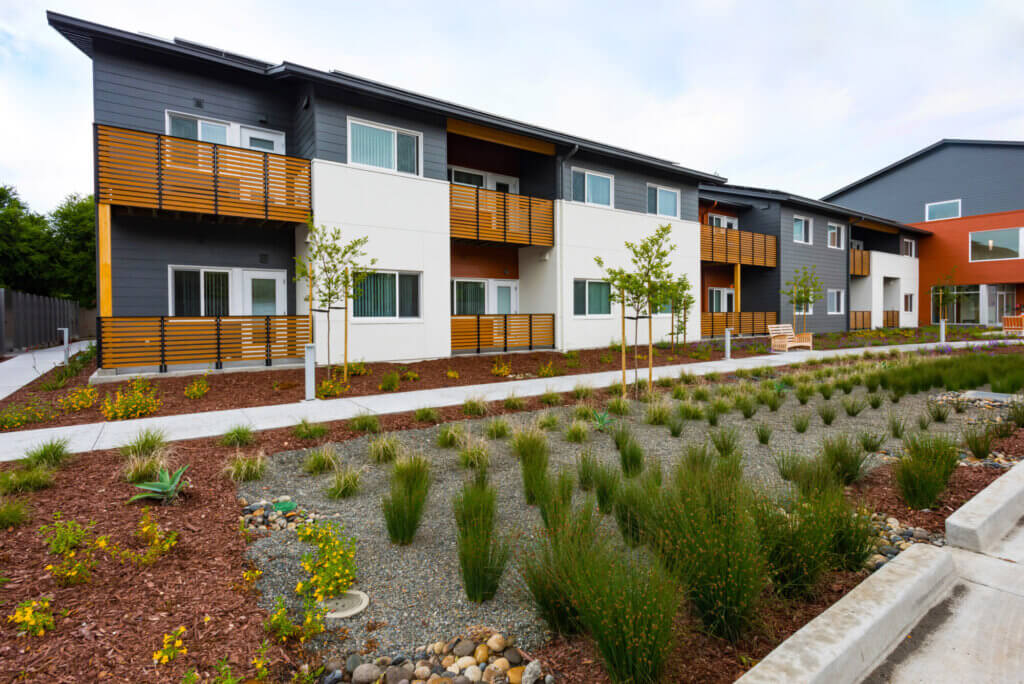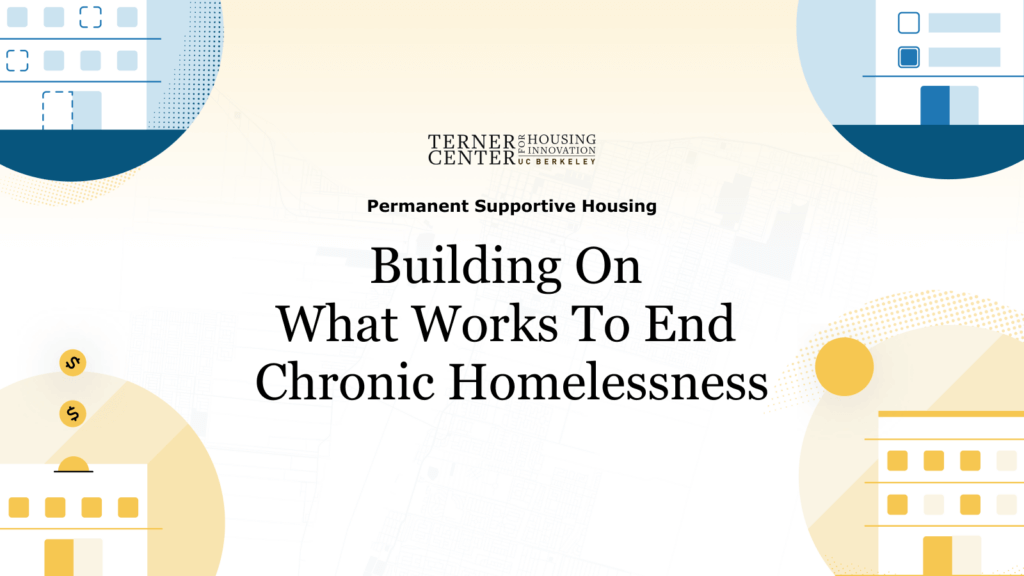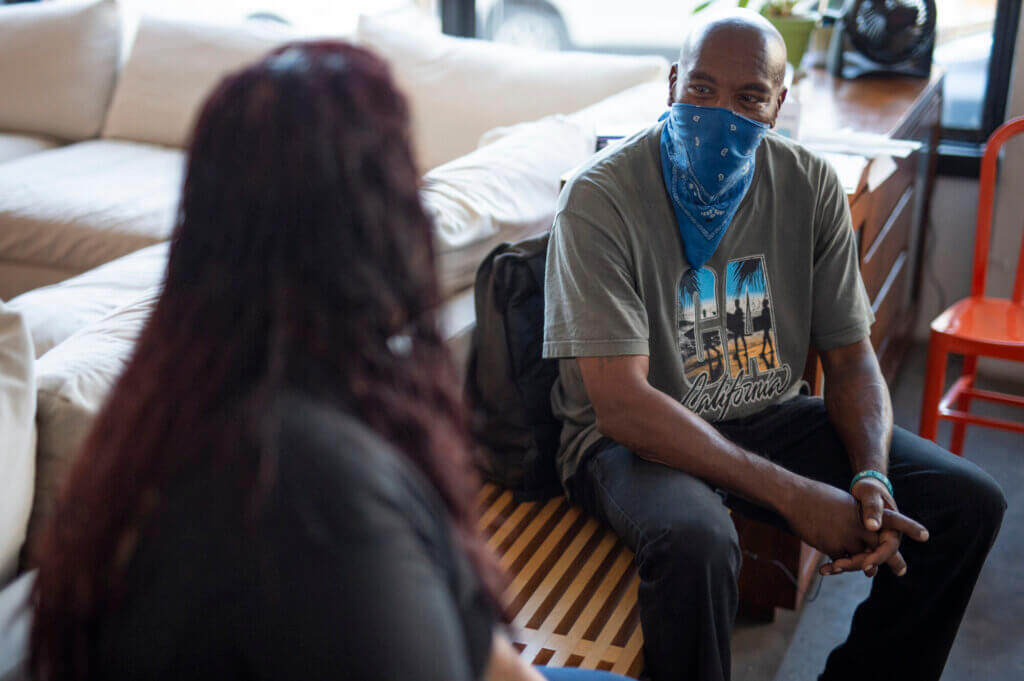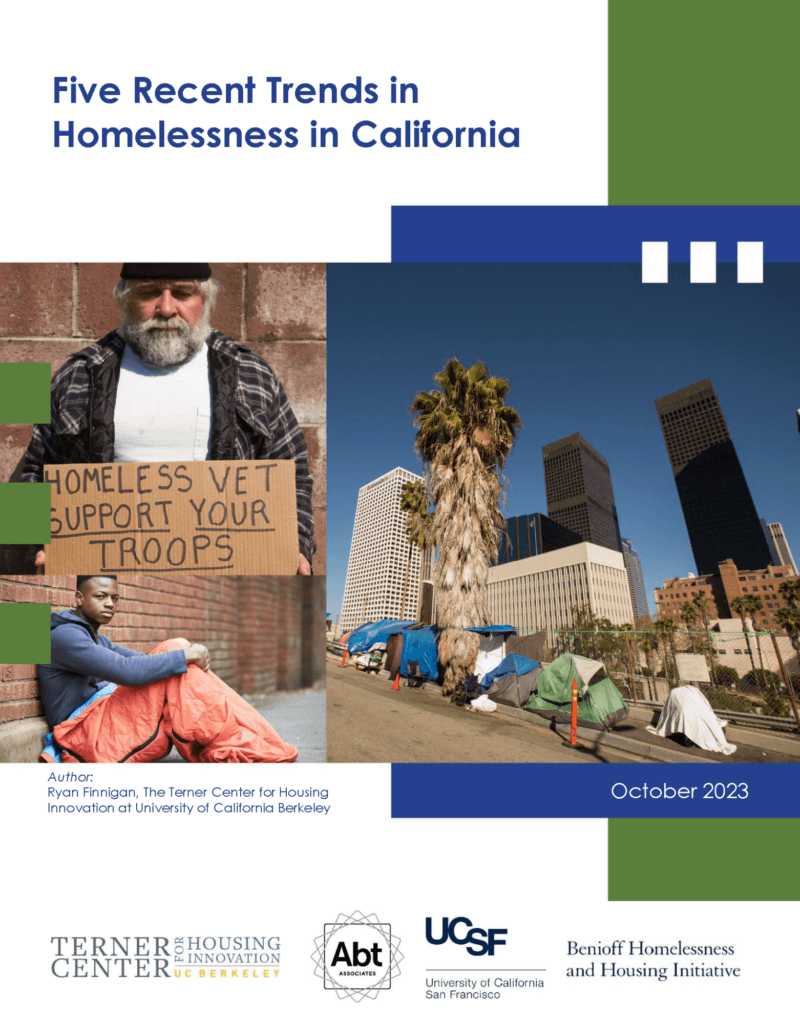How Homelessness Programs Are Serving Four Populations in California
Published On November 13, 2023
California’s affordable housing shortage and enduring poverty are major drivers of the state’s homelessness crisis,1 but efforts to resolve or prevent homelessness are most effective when targeted to people’s specific circumstances. Homelessness services, shelter, and housing programs in California serve a diverse population, and there are often different programs for different groups of people, such as families, unaccompanied youth, or adults living without children. To understand how homelessness programs are working to address the distinct needs of different groups of people, the Terner Center collaborated with Abt Associates and UCSF’s Benioff Homelessness and Housing Initiative (BHHI) to produce a series of research briefs on how homelessness programs are serving four populations in California:
- Unaccompanied children (under 18 years-old) and young adults (18–24 years-old)
- Older adults (at least 50 years-old)
- Families with children
- Veterans
These groups, while not reflecting everyone experiencing homelessness, have distinct needs and there are often specific programs aimed at serving them. To better understand who was being served within these populations and their outcomes, we analyzed data from the State of California’s new Homeless Data Integration System (HDIS), which aggregates and processes data from local homelessness service, shelter, and housing providers. The briefs present findings on how many people in each population were served by these programs over a three-year study period (2018–2021), their characteristics, and their housing situations at the end of the period.
This commentary highlights key findings from across the four briefs, supplemented by findings from the interviews our teams conducted with people with lived experience of homelessness, service providers, and local administrators.
Federal and state policies have prioritized families and veterans for housing; the data show these efforts lead to higher rates of housing placements.
Nearly 70 percent of people in families were housed at the end of the assessment period, compared to just 35 percent of adults living without children (also called “adult individuals”). This difference reflects both the different circumstances of and the existing programs serving families and adults individuals. A recent statewide study found that families were more likely than adult individuals to report that they were experiencing their first episode of homelessness, and they were more likely to reach out and receive assistance.2 In contrast, adult individuals were more commonly experiencing long-term or repeated homelessness and lived in unsheltered settings like tents or vehicles.
Stakeholders attributed these outcomes for people in families to commitments “to make sure we have permanent housing resources for families. So that’s where we see the most of any population exit from interim housing to permanent housing”, as one interviewee reported.3 Nearly half (47 percent) of people in families were served by rapid re-housing programs, which are designed to help people who recently entered homelessness quickly find housing on the private market through housing navigation assistance and time-limited rental subsidies. About 20 percent of people in families were served exclusively by homelessness prevention programs—primarily rental assistance programs—and the data recorded fewer than one percent of these families entering homelessness.
In contrast, both the HDIS data and stakeholder interviews show that adult individuals are less likely to be served by rapid re-housing or prevention programs. Instead, adult individuals most often stayed in emergency shelters (48 percent) or were in contact with street outreach programs (34 percent). Adult individuals were also less likely to be stably housed after leaving these programs. One interviewee acknowledged “a frustration for people in terms of the family system versus the adult system. I would say that the family system has been much more successful in our [area], just because it feels like there are more resources for families.”4 Interviewees said homelessness programs for adult individuals are significantly under-resourced given levels of need, and the lack of housing options is the biggest barrier to addressing chronic homelessness in their communities.
When resources are targeted to adult individuals’ needs, such as with veterans, the data show progress: 56 percent of veteran adult individuals were housed at the end of the assessment period, compared with 32 percent of non-veteran adult individuals. Higher shares of veterans than non-veterans were served by transitional housing, rapid re-housing, and permanent supportive housing programs through veteran-specific programs. These differences reflect dedicated resources for ending homelessness among veterans. The Supportive Services for Veteran Families (SSVF) program through the U.S. Department of Veterans Affairs (VA) helps quickly rehouse veterans with very low incomes who are experiencing or are at imminent risk of homelessness. The U.S. Department of Housing and Urban Development (HUD) and VA Supportive Housing (HUD-VASH) program combines case management and clinical services provided through the VA with Housing Choice Vouchers from HUD. Research has shown the HUD-VASH program has helped reduce homelessness among veterans nationwide.5
The effectiveness of these programs in California has been further enhanced by the Veterans Housing and Homelessness Prevention Program (VHHP), which provides funds to develop affordable housing for veterans and their families. The number of veterans experiencing homelessness in California declined 41 percent between 2010 and 2022. Some communities have succeeded in effectively ending veteran homelessness—one stakeholder noted their Continuum of Care (CoC) reached “functional zero with veterans” for the previous two years, meaning the number of veterans experiencing homelessness at any point was within the community’s capacity to quickly rehouse them.6
Interviewees explicitly highlighted these programs as examples for serving all adult individuals more effectively. One stakeholder said, “I’d recommend that to improve what we’re doing, we would model what the VA is doing for veterans. … they listen to their grantees, about all of the complaints and issues and what’s not working, what’s working. And they actually take that feedback, and they go and lobby Congress for more money to fill in those gaps. And you see results.”7
Age, gender, race, and ethnicity all intersect with family status to shape the circumstances and needs of people served by homelessness programs.
The different housing outcomes between groups overlap with demographic differences in age, gender, race, and ethnicity, with implications for equity in homelessness programs. Seventy-one percent of adults in families were women, and 54 percent families were headed by a single adult woman. The overrepresentation of people of color among those served by homelessness programs was greater among families than other groups: 83 percent of people in families identified as a race/ethnicity other than non-Hispanic/non-Latinx White.8 Adults in families also tended to be younger than adult individuals, including about 6,400 youth parents (adults 18–24 years-old living with their children but no adults aged 25 or older)—79 percent of whom were women of color. Youth parents often need high levels of assistance to find housing, support the children, and maintain the parents’ own ongoing development.9
Individuals varied widely in their demographics and circumstances. About 11 percent of individuals were unaccompanied children or young adults (18–24 years-old). Compared to adult individuals who were at least 25 years-old, high shares of unaccompanied children and young adults identified as people of color and as transgender or gender non-conforming/questioning. Homelessness among unaccompanied children and young adults often follows substantial family instability—such as the death of a parent or guardian or parental rejection of LGBTQ+ identities—or institutional involvement—such as release from the juvenile justice system or aging out of the foster care system. Youth often prefer to participate in services with their peers.10 In interviews, youth homelessness service providers repeatedly described the importance of youth-dedicated services for effectively meeting their needs. One interviewee noted that service providers need to consider “the development and the trauma, and all of those kinds of components that come in when working with [youth].”11 Organizations that serve both younger and older adults may not be able to meet young adults’ specific needs.
Homelessness is also increasingly prevalent among older adults. Just over 40 percent of individuals were at least 50 years-old when they were first served by homelessness programs during the study period. Compared to younger individuals, higher shares of these approximately 141,000 older adult individuals identified as males and as non-Hispanic/non-Latinx White. Forty percent were experiencing chronic patterns of homelessness—homelessness for at least one year in the previous three plus a disabling condition—the highest rate of all age groups.
Both service providers and people with lived experience of homelessness described a need for more resources to adequately serve people with multiple health conditions and/or chronic patterns of homelessness. One older adult who was sleeping in a park at the time of her interview explained that she couldn’t find an available shelter bed for her and her male partner, and sleeping outside aggravated her physical health conditions: “I’m in pain all the time, because my whole spine is mangled.”12 A new shelter facility was under construction nearby, and a local outreach worker told the interviewee she would be prioritized for a bed along with her partner due to her age and disability. Service providers said that shelters with accommodations for people with disabilities are critical for addressing unsheltered homelessness, but they often need more resources to make these facilities more accessible.
Stakeholders across the state noted that they were aware of differences in programmatic outcomes for different populations, and described growing efforts to assess equity in interventions and outcomes. Interviewees said that documenting racial disparities and other differences between groups can be “a wake-up call,” but these analyses are also just the first step.13 Many CoCs have established working groups led by people of color with lived experience of homelessness to discuss disparities and identify solutions. As one interviewee put it: “the question is, how do we address that? What does the CoC do about that? I think those conversations are happening right now.”14 Interviewees also emphasized the importance of continued monitoring for equity in program data, as well as ongoing effort to improve equitable service provision and outcomes.
The data point to the need for sustained resources and well-targeted programs to prevent and end homelessness in California.
Even as progress has been made, particularly among families and veterans, many more people still need housing. Though veterans were housed more often than non-veterans, 41 percent were not yet recorded as housed at the end of the assessment period. Only 25 percent of older adults experiencing chronic patterns of homelessness were recorded as living in permanent supportive housing during the assessment period, despite being prioritized for housing placements in many CoCs.
Investments are needed along the full spectrum of housing and services, including for people at risk of homelessness. Stakeholders emphasized the need for more homelessness prevention resources—rental assistance, eviction protection, and other short-term crisis resolution assistance—to help people stay housed and avoid developing high levels of service needs in the first place. Stakeholders shared that COVID-19 relief funds were critical in expanding prevention resources. One stakeholder explained, “Pre-Covid, there was an unmet need”, then “we doubled our financial assistance” due to the federal government’s Emergency Rental Assistance Program and other responses to the COVID-19 pandemic.15 COVID-response funding was finite, however. Stakeholders also described difficulty securing ongoing funding for prevention efforts in the face of political pressures to expand emergency shelters and reduce unsheltered homelessness. One interviewee explained that “there is so much reaction in the community, that everybody goes straight to shelter… [but] if you do more prevention and more permanent housing, you don’t need any more shelter.”16 Interviewees highlighted that prevention efforts can avert significant suffering while being less costly than serving someone after they enter homelessness. However, research has shown homelessness prevention programs must be able to reach the people most at risk of homelessness to be both effective and an efficient use of resources.17
Finally, interviewees in all parts of the state emphasized the need to continue developing housing, including more permanent supportive housing. People cannot move on from shelters without housing units to move into, and rapid re-housing assistance or housing vouchers cannot help if people cannot find housing units to use them.18 Unprecedented federal, state, and local resources have been directed toward producing affordable housing in recent years,19 and these efforts must be sustained to resolve the state’s homelessness crisis.20 When asked what would help resolve homelessness, one interviewee experiencing homelessness said, “What I believe would help is if you guys will find land and build housing. … Build and build and build them. … House the people, and get them indoors.”21
These briefs are intended to provide data about how homelessness programs are working to meet the housing and service needs for distinct populations. While only a snapshot in time, they show efforts to address homelessness can work well with sufficient resources and targeting. By building on these lessons, homelessness can become rare, brief, and non-recurring for all people in California.
We would like to thank the California Interagency Council on Homelessness (Cal ICH), which provided funding to support the data collection for this research collaboration and series. Cal ICH did not have a role in analyzing the data or interpreting the findings for this set of reports.
Endnotes
- Kushel, M., et al. (2023). “Toward a New Understanding: The California Statewide Study of People Experiencing Homelessness.” UCSF Benioff Homelessness and Housing Initiative. Retrieved from: https://homelessness.ucsf.edu/our-impact/our-studies/california-statewide-study-people-experiencing-homelessness.
- Kushel, M., Moore, T., et al. (2023).
- Stakeholder interview, Southern California, May 17, 2022.
- Stakeholder interview, Southern California, May 24, 2022.
- U.S. Department of Housing and Urban Development. (n.d.). “HUD-VASH Vouchers.” Retrieved from: https://www.hud.gov/program_offices/public_indian_housing/programs/hcv/vash; Montgomery, A.E., et al. (2013). “Housing Chronically Homeless Veterans: Evaluating the Efficacy of a Housing First Approach to HUD-VASH.” Journal of Community Psychology, 41, no. 4: 505–514, https://doi.org/10.1002/jcop.21554.
- Stakeholder interview, Bay Area, April 8, 2022.
- Stakeholder interview, Bay Area, June 27, 2023.
- Systemic racism elevates the risk of homelessness for People of Color, resulting in a higher share of People of Color among those served by homelessness programs compared to the state’s overall population. These racial and ethnic demographics of people in families compared with adult individuals partly reflect the demographics of California’s overall population: People of Color tend to be younger and in families with children more often than non-Hispanic/non-Latinx White people.
- Dworsky, A., Morton, M.H., & Samuels, G.M. (2018). “Missed Opportunities: Pregnant and Parenting Youth Experiencing Homelessness in America.” Chapin Hall at the University of Chicago. Retrieved from https://voicesofyouthcount.org/brief/pregnant-and-parenting-youth-experiencing-homelessness.
- Henwood, B., Redline, B., & Rice, E. (2018). “What Do Homeless Transition-Age Youth Want from Housing Interventions?” Children and Youth Services Review, 89: 1–5, https://doi.org/10.1016/j.childyouth.2018.04.014.
- Stakeholder interview, Southern California, June 28, 2022.
- Lived experience interview, San Joaquin Valley, June 10, 2022.
- Stakeholder interview, Bay Area, May 19, 2022.
- Stakeholder interview, San Joaquin Valley, April 8, 2022.
- Stakeholder interview, Bay Area, July 7, 2022.
- Stakeholder interview, Greater Sacramento, May 12, 2022.
- Shinn, M., et al. (2013). “Efficient Targeting of Homelessness Prevention Services for Families.” American Journal of Public Health, 103: S324_S330, https://doi.org/10.2105/AJPH.2013.301468; Von Wachter, T., et al. (2019). “Predicting and Preventing Homelessness in Los Angeles.” California Policy Lab. Retrieved from: https://www.capolicylab.org/predicting-preventing-homelessness-la/.
- Economy, C., Finnigan, R., & Espinoza, M. (2023). “Using Emergency Housing Vouchers to Address Homelessness.” Terner Center for Housing Innovation, retrieved from: https://ternercenter.berkeley.edu/research-and-policy/emergency-housing-vouchers-lessons/.
- California Interagency Council on Homelessness. (2023). “Statewide Homelessness Assessment (July 1, 2018–June 30, 2021): Report to the Legislature.” Retrieved from: https://bcsh.ca.gov/calich/documents/homelessness_assessment.pdf.
- Corporation for Supportive Housing. (2022). “The California Homeless Housing Needs Assessment.” Retrieved from: https://calneeds.csh.org/wp-content/uploads/2023/01/CSH_The-California-Homeless-Housing-Needs-Assessment-Report_Final.pdf.
- Lived experience interview, Greater Sacramento, June 23, 2022.





